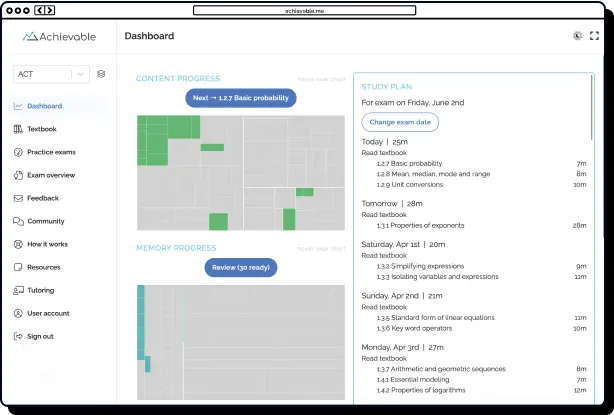
SAT or ACT: A quick guide




Table of contents
College admissions represent a crucial milestone for your career goals, with standardized testing remaining one of its most debated elements. As prestigious universities reintroduce test requirements and move away from test-optional policies, students across the country are taking a closer look at the ACT, SAT, and the strengths of each exam format. Deciding between the SAT vs. ACT has taken on added significance, especially with recent updates: the digital SAT format, explained in detail in this digital SAT format overview, and the rollout of revised ACT sections and formats.
Understanding the differences in the SAT and ACT, including distinctions in scoring ranges, section types, and preparation approaches, can guide you toward the optimal choice for your abilities and academic goals. This article offers a concise comparison of the SAT and ACT, highlighting the primary advantages and disadvantages of each exam for different learners. By analyzing important exam details, you’ll be better equipped to determine which standardized test aligns with your college admission aspirations.

The testing format
The SAT and ACT are both timed standardized tests, each with unique structures and timing strategies that impact student performance and preparation. Understanding how SAT sections and ACT sections are organized can help you manage your time effectively and ultimately improve your test outcomes.
The SAT divides its exam into two primary sections: Reading & Writing and Math. Each of these SAT sections is further broken down into two modules. In the Reading and Writing modules, you receive 32 minutes to answer 27 questions in each, while each Math module provides 35 minutes to tackle 22 questions. Overall, the total SAT testing time (excluding breaks) amounts to 2 hours and 14 minutes.
Conversely, the ACT consists of several distinct sections. The required sections include English, Mathematics, and Reading. The English section gives you 35 minutes to complete 50 questions, while the Mathematics section allocates 50 minutes to complete 45 questions. For the Reading section, you are given 40 minutes to solve 40 questions. The ACT also offers optional Science and Writing sections: the Science section consists of 40 questions in 40 minutes, and the optional Writing section allows 40 minutes to write an essay. Knowing this scoring structure can help you set realistic goals within the ACT score range.
SAT vs. ACT comparison chart
| Feature | SAT | ACT |
|---|---|---|
| Total Sections | 2 sections (Reading and Writing, Math) | 4 composite sections (English, Math, Reading, Science (optional)) + Writing (optional) |
| Timing | 2 hours 14 minutes | 2 hours 55 minutes composite (Science included), 3 hours 35 minutes with Writing |
| Number of Questions | 154 | 215 |
| Scoring | Composite: 400 - 1600 (200 - 800 per section) | Composite: 1 - 36 (average of section scores, also scored from 1 - 36), Writing: 2 - 12 |
| Are calculators allowed on Math sections? | Yes, a digital calculator is built into the test interface. | Yes, handheld calculators are allowed. |
| Digital or paper | As of 2024, SAT exams are administered digitally in an adaptive format, with some exceptions. | Distributed both digitally (as of 2025) and on paper. The digital exam format is adaptive. |
A notable difference between SAT sections and ACT sections is the time pressure per question. While the SAT allows test-takers to spend around a minute on each question, allowing them to finish with time to review, the ACT is much more rigorous. For example, in some ACT sections like English, you only have about 40 seconds per question. While it may seem that the ACT is harder due to tighter timing, these differences often reflect distinctive question styles rather than overall difficulty.
Recognizing how SAT sections and ACT sections allocate time and structure questions will help you make a knowledgeable decision about which exam best suits your strengths.
Math
One of the most noticeable differences highlighted in any ACT vs. SAT comparison chart is the style of questions, particularly in the math sections. Many students have found that ACT Math questions are much more straightforward than those on the SAT. If you’re someone who excels at quickly applying math concepts and prefers direct questions, you’ll likely find ACT Math easier.
On the other hand, if you enjoy tackling creative problem-solving and appreciate having time to analyze each math question, SAT Math may suit you better. The SAT often rewards students who enjoy exploring different approaches to a problem before settling on an answer.
Both the SAT and ACT allow calculator use, but there are key distinctions in the math resources provided. The SAT provides a formula sheet with essential geometric formulas, making it easier for those who are less comfortable with memorization. The ACT expects you to recall all necessary formulas from memory. If memorizing formulas is not your strength, the SAT might be a better fit, especially since several ACT Math questions require specific geometric knowledge.
Neither test provides algebraic formulas like the quadratic or distance formula: you’ll need to know these for both exams. Neither the SAT nor ACT includes calculus content, so if your current math level is Algebra 2, you’ll recognize every topic presented on either test.
Reading & Writing
Every passage in the Reading and Writing section of the SAT is unique: each question featuring a short passage draws from a completely new text, requiring you to read and comprehend fresh material every time. The ACT Reading section uses one longer passage per set, so while it may take a bit more time to read initially, your understanding of that single passage supports you through about 10 related questions. For students who can quickly process information, the ACT Reading section can be a great fit. If you prefer to take your time analyzing shorter texts, the SAT Reading and Writing section may feel more approachable.
Unlike the SAT, the ACT divides language skills into two separate areas: Reading and English. Together, these ACT sections assess many of the same abilities as the SAT’s combined Reading and Writing section. Each section of the ACT is weighted equally, which means your performance in English and Reading has a greater impact on your overall ACT scores compared to Math. This is a key consideration when deciding which test to take for college admissions. If English is your strong suit and math is less of a strength, the ACT may offer an advantage by emphasizing your language skills more heavily than the SAT.
With this information in mind, you can select the exam that best aligns with your strengths and goals. Analyzing scores data helps guide your preparation strategy and maximizes your potential for college admissions.

Conclusion
Both the SAT and ACT are challenging standardized tests, designed to accurately assess your college readiness. When comparing the SAT vs. the ACT, it’s important to remember that neither exam is universally easier: each test has its own style and focus areas. For some students, the SAT may align better with their analytical strengths, especially if they prefer more time to process information and excel at in-depth reasoning. On the other hand, the ACT tends to benefit students who work quickly and are comfortable with a faster-paced testing environment, even if their analytical reasoning skills are not as strong.
Ultimately, when deciding between the SAT and ACT, the best approach is to take official practice tests for both exams. Evaluate your performance and comfort level on each test format, then choose the one that plays to your strengths and feels more manageable. With dedicated SAT or ACT preparation, you can succeed on either exam.

